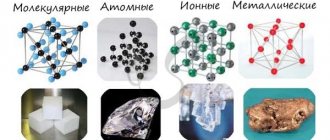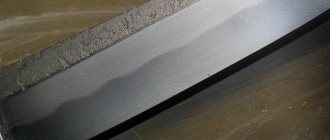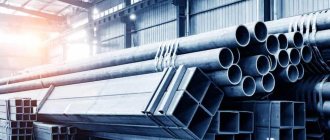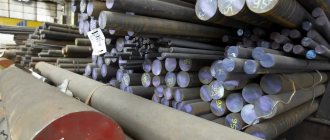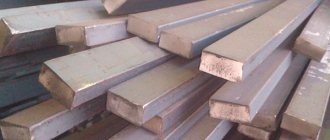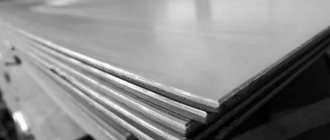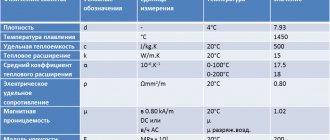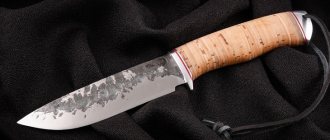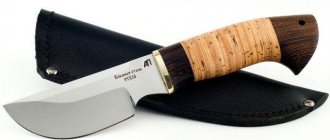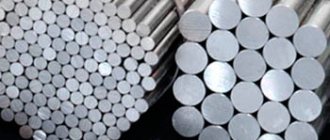General characteristics of the alloy
The main alloying element in the production of grade 20x13 (the characteristics of steel largely depend on the concentration of chemicals in the composition) was chromium. Its addition to the metal composition is carried out over a long period. The main characteristics of plastic are as follows:
- Limited degree of weldability. The metal in question is characterized by a low degree of machinability. In most cases, the material is heated to increase the degree of weldability.
- Heat resistance and low thermal conductivity are properties that significantly expand the range of the material under consideration. Corrosion-resistant, heat-resistant steel 20X13 can be operated at temperatures up to 700 degrees Celsius. Increasing the temperature to higher levels leads to a significant decrease in the properties of the material: hardness, resistance to deformation, and others.
- Hardness is maintained at a level of 126-197 MPa, depending on whether heat treatment was carried out.
- The structure is prone to temper brittleness; it is possible to carry out cutting processing.
Mechanical properties of steel 20Х13 at different temperatures
The main characteristics of the alloy determine the possibility of its use in the manufacture of a wide variety of products. If necessary, they can be improved by heat treatment, for example, hardening or annealing.
Steel 20Х13 corrosion-resistant, heat-resistant, martensitic
Substitutes for steel 20Х13
Steel 12Х13, 14Х17Н2
Foreign analogues
| Germany DIN | Brand | Х20Cr13 |
| Number | 1.4021 | |
| USA (AISI, SAE, ASTM) | 420 | |
| France (AFNOR) | Z20С13 | |
| UK (BS) | 420S37 | |
| Sweden (SS) | 2303 | |
| Italy UNI | X20Cr13 | |
IMPORTANT!!! The possibility of replacement is determined in each specific case after assessing and comparing the properties of steels
Decoding steel 20Х13
The number 20 indicates the average carbon content in hundredths of a percent, i.e. for steel 20Х13 this value is 0.20%.
The letter “X” indicates the chromium content of the steel. The number 13 after the letter “X” indicates the approximate amount of chromium in steel as a percentage, rounded to the nearest whole number, i.e. chromium content about 13%.
Type of delivery
- Long products, including shaped steel: GOST 5949-75, GOST 2590-88, GOST 2591-88, GOST 2879-88, GOST 18968-73, GOST 19442-74.
- Calibrated rod GOST 8559-75, GOST 8560-78, GOST 7417-78.
- Polished rod and silver steel GOST 14955-77, GOST 18907-73.
- Thick sheet GOST 7350-77. Thin sheet GOST 5582-75.
- Tape GOST 4986-79.
- Strip GOST 4405-75, GOST 103-76, GOST 18968-73.
- Wire GOST 18143-72.
- Forgings and forged blanks GOST 1133-71, GOST 18968-73, GOST 25054-81.
- Pipes GOST 14162-79.
Characteristics and purpose
Steel 20Х13 belongs to corrosion-resistant, heat-resistant martensitic steels (main structure is martensite). Steel 20X13 is used for the manufacture of parts with increased ductility, subjected to shock loads and operating at temperatures up to 450-500 ° C, as well as products exposed to mildly aggressive environments at room temperature.
Weldability
Steel 20X13 has limited weldability. Welding methods RDS, ArDS and KTS. Heating and subsequent heat treatment are used depending on the welding method, type and purpose of the structure.
Maximum permissible temperature for using steel 20Х13 in environments containing ammonia
| steel grade | Temperature of application of steels, °C at partial pressure of ammonia, MPa (kgf/cm) | ||
| St. 1(10) to 2(20) | St. 2(20) to 5(50) | St. 5(50) to 8(80) | |
| 20Х13 | 540 | 540 | 540 |
Maximum permissible temperature for using steel 20Х13 in hydrogen-containing environments
| steel grade | Temperature, °C, at partial pressure of hydrogen, PH2, MPa (kgf/cm2) | ||||||
| 1,5(15) | 2,5(25) | 5(50) | 10(100) | 20(200) | 30(300) | 40(400) | |
| 20Х13 | 510 | 510 | 510 | 510 | 510 | 510 | 510 |
NOTE
- The parameters for using steels indicated in the table also apply to welded joints.
- The partial pressure of hydrogen is calculated by the formula: PH2 = (C*Pp)/100, where C is the percentage in the system; PH2—hydrogen partial pressure; Pp is the operating pressure in the system.
Resistance of steel 20Х13 against crevice erosion
| Durability group | Point | Erosion resistance against steel 12X18H10T |
| Persistent | 2 | 0,75-1,5 |
Application of steel 20Х13 for the manufacture of main parts of nuclear power plant fittings
| steel grade | Type of semi-finished product or product | Maximum permissible temperature of use, °C |
| 20Х13 GOST 5632, GOST 24030 | Sheets, pipes, forgings, long products. Fasteners | 600 |
Chemical composition, % (GOST 5632-2014)
| WITH | Si | Mn | Cr | Ni | Ti | S | R |
| no more | no more | ||||||
| 0,16-0,25 | 0,8 | 0,8 | 12,0-14,0 | — | — | 0,025 | 0,030 |
Chemical composition, % (GOST 5632-81)
| WITH | Si | Mn | Cr | S | R | Ti | Cu | Ni |
| no more | no more | |||||||
| 0,16-0,25 | 0,8 | 0,8 | 12,0-14,0 | 0,025 | 0,030 | 0,2 | 0,30 | 0,6 |
Physical properties
Modulus of normal elasticity E, GPa
| steel grade | At test temperature, °C | |||||||||
| 20 | 100 | 200 | 300 | 400 | 500 | 600 | 700 | 800 | 900 | |
| 20X13 | 218 | 214 | 208 | 200 | 189 | 181 | 169 | — | — | — |
Modulus of elasticity in torsional shear G, GPa
| steel grade | At test temperature, °C | |||||||||
| 20 | 100 | 200 | 300 | 400 | 500 | 600 | 700 | 800 | 900 | |
| 20X13 | 86 | 84 | 80 | 78 | 73 | 69 | 63 | — | — | — |
Density ρ kg/cm3 at test temperature, °C
| Steel | 20 | 100 | 200 | 300 | 400 | 500 | 600 | 700 | 800 | 900 |
| 20X13 | 7670 | 7660 | 7630 | 7600 | 7570 | 7540 | 7510 | 7480 | 7450 | — |
Thermal conductivity coefficient λ W/(m*K) at test temperature, °C
| Steel | 20 | 100 | 200 | 300 | 400 | 500 | 600 | 700 | 800 | 900 |
| 20X13 | — | 26 | 26 | 26 | 26 | 27 | 26 | 26 | 27 | 28 |
Electrical resistivity ρ nom*m
| steel grade | At test temperature, °C | |||||||||
| 20 | 100 | 200 | 300 | 400 | 500 | 600 | 700 | 800 | 900 | |
| 20X13 | 588 | 653 | 730 | 800 | 884 | 952 | 1022 | 1102 | — | — |
Linear expansion coefficient α*106, K-1, at test temperature, °C
| Steel | 20-100 | 20-200 | 20-300 | 20-400 | 20-500 | 20-600 | 20-700 | 20-800 | 20-900 | 20-1000 |
| 20X13 | 10,2 | 11,2 | 11,5 | 11,9 | 12,2 | 12,8 | 12,8 | 13,0 | — | — |
Specific heat capacity c, J/(kg*K), at test temperature, °C
| Steel | 20-100 | 20-200 | 20-300 | 20-400 | 20-500 | 20-600 | 20-700 | 20-800 | 20-900 | 20-1000 |
| 20X13 | 112 | 117 | 123 | 127 | 132 | 137 | 147 | 155 | 159 | — |
Temperature of critical points, °C
| Ac1 | Ac3 | Ar3 | Ar1 | Mn |
| 810 | 900 | 660 | 710 | 320 |
Mechanical properties
| GOST | Delivery status | Széchenyi | σ0.2, MPa | σв, MPa | δ5, % | ψ% | KCU, J/cm2 |
| no less | |||||||
| GOST 5949-75 | Bar. Hardening from 1000-1050 °C in air or oil; holiday at 600-700 °C, cool. in air or oil | 60 | 635 | 830 | 10 | 50 | 59 |
| Bar. Hardening from 1000-1050 °C in air or oil; holiday at 660-770 °C, cool. in air, oil or water | 60 | 440 | 650 | 16 | 55 | 78 | |
| GOST 18907-73 | Ground rod, processed to a specified strength | 1-30 | — | 510-780 | 14 | — | — |
| GOST 7350-77 | The sheet is hot-rolled or cold-rolled. Hardening from 1000-1050 °C in air; holiday at 680-780 °C, cool. in air or with an oven (transverse samples) | St. 4 | 372 | 509 | 20 | — | — |
| GOST 25054-81 | Forging. Hardening from 1000-1050 °C in air or oil | 1000 | 441 | 588 | 14 | 40 | 39 |
| GOST 4986-79 | Cold rolled strip. | Up to 0.2 | — | 500 | 8 | — | — |
| Annealing or tempering at 740-800 °C | 0,2-2,0 | — | 500 | 16 | — | — | |
| GOST 18143-72 | Heat treated wire | 1,0-6,0 | — | 490-780 | 14 | — | — |
Mechanical properties of workpieces with a cross-section of 14 mm depending on the tempering temperature
| tref.°С | σ0.2, MPa | σв, MPa | δ5, % | ψ% | KCU, J/cm2 | Hardness HRCе |
| 200 | 1300 | 1600 | 13 | 50 | 81 | 46 |
| 300 | 1270 | 1460 | 14 | 57 | 98 | 42 |
| 450 | 1330 | 1510 | 15 | 57 | 71 | 45 |
| 500 | 1300 | 1510 | 19 | 54 | 75 | 46 |
| 600 | 920 | 1020 | 14 | 60 | 71 | 29 |
| 700 | 650 | 78 | 18 | 64 | 102 | 20 |
| 700 | 650 | 78 | 18 | 64 | 102 | 20 |
NOTE. Hardening at 1050 °C in air.
Mechanical properties at elevated temperatures
| tsp.°C | σ0.2, MPa | σв, MPa | δ5, % | ψ% | KCU, J/cm2 |
| Normalization at 1000-1020 °C; holiday at 730-750 °C. At 20 °СНВ 187-217 | |||||
| 20 | 510 | 710 | 21 | 66 | 64-171 |
| 300 | 390 | 540 | 18 | 66 | 196 |
| 400 | 390 | 520 | 17 | 59 | 196 |
| 450 | 370 | 480 | 18 | 57 | 235 |
| 500 | 350 | 430 | 33 | 75 | 245 |
| 550 | 275 | 340 | 37 | 83 | 216 |
| Sample with a diameter of 6 mm and a length of 30 mm, rolled. Deformation speed 16 mm/min; strain rate 0.009 1/s | |||||
| 800 | 59 | 70 | 51 | 98 | — |
| 850 | — | — | 43 | — | — |
| 900 | — | — | 66 | — | — |
| 1000 | 39 | 61 | 59 | — | — |
| 1150 | 21 | 31 | 84 | 100 | — |
Mechanical properties of rods at negative temperatures
| tsp.°C | σ0.2, MPa | σв, MPa | δ5, % | ψ% | KCU, J/cm2 |
| Section 25 mm. Normalization at 1000 “C, cool. on air; holiday at 680-750 °C | |||||
| +20 | 540 | 700 | 21 | 62 | 76 |
| -20 | 560 | 730 | 22 | 59 | 54 |
| -40 | 580 | 770 | 23 | 57 | 49 |
| -60 | 570 | 810 | 24 | 57 | 41 |
| Section 14 mm. Hardening at 1050 °C in air; tempering at 600 °C | |||||
| +20 | — | — | — | — | 71 |
| -20 | — | — | — | — | 81 |
| -60 | — | — | — | — | 64 |
Mechanical properties during long-term strength testing
| tsp.°C | Creep limit, MPa | Creep rate, %/h | tsp.°C | Long-term strength limit, MPa | τ, h |
| 450 | 125 | 1/100000 | 450 | 289 | 10000 |
| 470 | 75 | 1/100000 | 470 | 191 | 10000 |
| 500 | 47 | 1/100000 | 500 | 255 | 100000 |
| 550 | 29 | 1/100000 | 550 | 157 | 100000 |
NOTE. Fatigue limit σ-1 = 367 MPa at n = 107 (smooth samples).
Mechanical properties depending on thermal exposure
| Heat treatment | Heat exposure | σ0.2, MPa | σв, MPa | δ5, % | ψ% | KCU, J/cm2 | |||||||
| tsp.°C | τ, h | ||||||||||||
| Normalization at 1000-1020 °C, cool. on air; holiday at 730-750 °C, cool. on air | 500 | 5000 | 500 | 690 | 20 | 62 | 108 | ||||||
| 10000 | 420 | 670 | 23 | 65 | 118 | ||||||||
| 550 | 1000 | 450 | 690 | 26 | 65 | — | |||||||
| 10000 | 440 | 660 | 24 | 63 | 108 | ||||||||
| 600 | 3000 | 450 | 660 | 21 | 60 | 78 | |||||||
| 10000 | 380 | 630 | 23 | 63 | 147 | ||||||||
Technological properties
Forging temperature, °C: beginning 1250, end 850. Sections up to 150 mm are cooled in air, sections 150-400 mm require low-temperature annealing with one supercooling.
Cutting machinability - Kv tv.spl = 0.7 and Kv b.st = 0.45 in the quenched and tempered state at HB 241 and σw = 730 MPa.
Flock sensitivity - not sensitive.
Tendency to temper brittleness - prone.
Corrosion resistance
| Wednesday | Temperature, °C | Test duration, h | Corrosion depth, mm/year |
| Distilled water or steam | 100 | — | 0,1 |
| Soil water 20 | — | 1,0 | |
| Sea water | 20 | 720 | 0 |
Find out more
Steel 20Х23Н18 heat-resistant, heat-resistant, stainless…
Steel 15HSND low-alloy structural...
Steel St2kp - carbon steel of ordinary quality...
Steel 6ХВ2С tool stamping…
Chemical composition
In many ways, 20x13 steel resembles its analogues, which also contain a large amount of chromium. The chemical composition is represented by a combination of the following substances:
- Carbon largely determines the hardness and strength of the material, as well as the degree of weldability. In the case under consideration, the carbon concentration can vary from 0.16 to 0.25%.
- Chromium is considered the main alloying element. About 12-14% of this chemical is added to the alloy composition. It is chromium that determines heat resistance and corrosion resistance.
- Manganese and nickel are not the main elements of the alloy in question; their concentration is no more than 0.6%.
Almost all metals contain phosphorus and sulfur. These chemical elements are present in the composition at a concentration of no more than 0.03%.
Stainless steel sheet 20X13
Foreign manufacturers also produce alloys with similar chemical compositions. For example, the Japanese analogue of steel 20x13 was called SUS420J1, the French alloys z20c13 and X20Cr13.
Steel composition
Now let's look at the most important component of any metal-containing alloy - its composition.
Thanks to official technical documents, anyone can determine with a high degree of accuracy exactly what elements are included in 20X13 steel. Their list is as follows:
- Carbon - 0.2% - an element without which steel cannot exist. It is this that gives soft iron strength and hardness. However, at this content the alloy still remains relatively ductile and can be machined, in some cases even without preheating.
- Silicon - 0.6% - an alloying additive that improves the structure of steel and allows it to better withstand overheating.
- Manganese - 0.6% - an additive in many ways similar to the previous one, however, manganese not only increases the hardenability of steel, but also increases its viscosity.
- Nickel - 0.6% - again an alloying element that increases the thermal stability of steel, its overall ductility and strength.
- Chromium - 13% - is no less important than carbon, because chromium is responsible for the strength of steel, its corrosion resistance, hardenability and conductivity.
At this stage, we can add that 20X13 is a heat-resistant steel that has exceptional resistance to elevated temperatures, if, of course, we compare it with other technical steels. In addition, the alloy is extremely insensitive to corrosion and oxidation due to the high chromium content in the composition.
If you know the characteristics of steel 20X13, the use of this alloy ceases to be a secret. With a high degree of probability these may be parts operating at high temperatures.
Application of steel 20x13
Steel 20x13 has a large number of features that determine its wide distribution. Heat resistance and corrosion resistance are valued in the following cases:
- Mechanical engineering industry.
- In the production of turbine blades, which are exposed to high temperatures and pressures.
- When creating fasteners with high strength and corrosion resistance.
- Production of parts that are exposed to atmospheric precipitation and organic sludge.
- In the manufacture of rings for various purposes.
- Aviation industry.
- Production of products operating at low temperatures and in aggressive chemical environments.
- When creating parts for compressor machines that work with non-toxic gases.
Tube boards 20x13
Heat treatment can significantly improve the performance characteristics of the alloy. This is due to the fact that with strong heating, the crystal lattice is rearranged to strengthen the structure and increase the hardness of the surface layer. The use of 20x13 steel made it possible to significantly extend the service life of products that serve in difficult operating conditions.
GOSTs and other standards for steel 20Х13
In order for the produced metals to be used in certain conditions, Gosstandart is used during their production. Steel 20×13 (GOST determines the release form and basic qualities) is manufactured taking into account the following standards:
- Forgings are supplied in square and round shapes.
- When using an alloy, wires with high performance characteristics can be produced.
- Rolled products with different sheet thicknesses, which are characterized by heat resistance and corrosion resistance, are supplied to production lines.
- Forged and hot-rolled strips are supplied to industry.
- Shaped profiles.
The classification of steel 20x13 determines a high concentration of chromium, which leads to a decrease in some performance qualities. An example is the inability to use sheet metal to make a body when using a welding machine. The established standard 20x13 GOST also determines the possibility of additional processing, which makes the structure more dense and durable, resistant to various types of influence.
Download GOST 5632-72
welding steel 20Х13 semi-automatically
and I accidentally acquired a ton of this steel, 5 mm thick.
The question is, it is impossible to anneal large-sized products, in my conditions of course. What are the properties of unannealed seams of this steel? especially at operating temperatures of -30-40? the seams are mechanically loaded only by their own stresses and a little more... what kind of trouble can be expected from an unannealed seam in the long term?
Dont be upset. Please note Nightfeather's :
- welding method (apparently more suitable for you): mechanized in an environment of inert gases (argon), or better in a mixture of 43% Ar + 55% He + 2% CO2 (this is too cool, only the Germans can anneal such 98% Ar +2%CO2 is quite satisfactory) on a direct current of reverse polarity.
— welding materials: austenitic solid wire with low carbon content, high nickel content in the deposited metal, high elongation type 309L, 309L Si (domestic type Sv.-08Х25Н13БТУ). Diameter 1.2 (I hesitate, I would put 1 for your case for the root, in no case in one pass) mm.
— preparation of edges: all butt edges must be grooved, all corner edges must have a guaranteed gap of at least a millimeter. I think this will allow the crystals to grow in the desired direction, which will to some extent reduce the risk of cracks. After all, we are surfacing metal with an austenitic structure.
— assembly of joints: using assembly devices. NO POCKETS. This will allow free shrinkage of the metal of the first welds in the structure and reduce overall welding stresses.
— welding modes:
shielding gas consumption - 12-15 l/min with a burner nozzle diameter of 16-18 mm (+ lens).
wire feed speed - 4-5 m/min for root, 6-7 m/min for base
arc voltage - 17-19V root, 20-22V base (I would experimentally select the minimum possible arc length)
welding current - 100-120A root 160-180A (also not a clear-cut question). Indeed, it is not good to force the currents and welding speed (you can read it here)
wire stick out - as expected 10 F of the electrode (if the machine is USSR without synergetics and everything else)
-welding technique: without “stirring” the electrode in the weld pool to reduce the proportion of base metal in the weld metal. The welding order must be followed as prescribed in the ABC books.
If the seam is double-sided, I think the last one should be the roller facing the aggressive environment.
Add to this heating before and after welding in order to get into QUIET and not shock the metal.
The modes can be simulated using the Weldability program from Bauman University, if necessary I can send it...
And then all the same night-time KSS for mechanical and chemical testing. analysis... Nickel in steel should not have enough blue brittleness if the technology is followed, maybe a wire is found with molybdenum and finally everything will be in chocolate...
I apologize to the authors of the quotes for copyright infringement. If something is not true, brand it with shame... criticism is useful to me...
